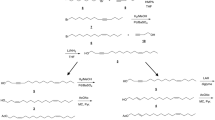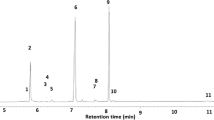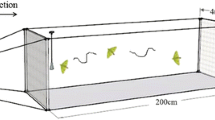Abstract
The response of individual male turnip mothsAgrotis segetum was observed in a sustained flight tunnel to a mixture of decyl acetate, (Z)-5-decenyl acetate, (Z)-7-dodecenyl acetate, and (Z)-9-tetradecenyl acetate in proportions similar to those found in gland extracts from virgin females (0.6: 1:5:2.5). Lures containing 3–30 μg (Z)-5-decenyl acetate proved to be maximally attractive, with approximately 60% of the males completing all behavioral steps from activation to copulation efforts. A 300-μg dosage caused significant arrestment of upwind flight. Peak response to synthetics, however, was significantly lower than to female glands. Omitting decyl acetate from the blend did not affect the activity, while omission of any of the three monounsaturated acetates caused a dramatic decrease in response. In the field maximum trap catches were achieved with 1- to 30-μg lures. The subtractive assay carried out in the field confirmed the neutrality of decyl acetate and the importance of the three monoenes. Adding 1% of (Z)-8-dodecenyl acetate (earlier reported as an “inhibitor”) to the four-component mixture decreased the trap catch to about 50%, and increasing the amount of (Z)-8-dodecenyl acetate to 27% decreased the activity further to about 10%. (Z)-8-Dodecenyl acetate also decreased the number of successful flights in the flight tunnel.
Similar content being viewed by others
References
Arn, H., Städler, E., Rauscher, S., Buser, H.R., Mustaparta, H., Esbjerg, P., Philipsen, H., Zethner, O., Struble, D.L., andBues, R. 1980. Multicomponent sex pheromone inAgrotis segetum: Preliminary analysis and field evaluation.Z. Naturforsch. 35C:986–989.
Arn, H., Esbjerg, P., Bues, R., Toth, M., Szöcs, G., Guerin, P., andRauscher, S. 1983. Field attraction ofAgrotis segetum males in four European countries to mixtures containing three homologous acetates.J. Chem. Ecol. 9:267–276.
Baker, T.C., andRoelofs, W.L. 1981. Initiation and termination of Oriental fruit moth male response to pheromone concentrations in the field.Environ. Entomol. 10:211–218.
Bellas, T.E., andBartell, R.J. 1983. Dose-response relationship for two components of the sex pheromone of light brown apple mothEpiphyas postvittana.J. Chem. Ecol. 9:715–726.
Bestmann, H.J., Vostrowsky, O., Koschatzky, K.-H., Platz, H., Brosche, T., Kantardjiew, I., Rheinwald, M., andKnauf, W. 1978. (Z)-5-Decenyl acetate, a sex attractant for the male turnip mothAgrotis segetum (Lepidoptera).Angew. Chem. 17(10):768.
Butler, L.I., andMcDonough, L.M. 1979. Insect sex pheromones. Evaporation rates of acetates from natural rubber septa.J. Chem. Ecol. 5:825–834.
Cardé, R.T. 1976. Utilization of pheromones in the population management of moth pests.Environ. Health Perspect. 14:133–144.
Cardé, R.T., andHagaman, T.E. 1979. Behavioral responses of the gypsy moth in a wind tunnel to airborne enantiomers of disparlure.Environ. Entomol. 8:475–484.
Hinks, C.F., andByers, J.R. 1976. Biosystematics of the genusEuxoa (Lepidoptera: Noctuidae). V. Rearing procedures and life cycles of 36 species.Can. Entomol. 108:1345–1357.
Kuenen, L.P.S., andBaker, T.C. 1982. The effect of pheromone concentration on the flight behavior of the oriental fruit mothGrapholitha molesta.Physiol. Entomol. 7:423–434.
Kuhr, R.J., Comeau, A., andRoelofs, W.L. 1972. Measuring release rates of pheromone analogues and synergists from polyethylene caps.Environ. Entomol. 1:625–627.
Linn, C.E., andRoelofs, W.L. 1981. Modification of sex pheromone blend discrimination in male oriental fruit moths by preexposure to (E)-8-dodecenyl acetate.Physiol. Entomol. 6:421–429.
Linn, C.E., Jr., andRoelofs, W.L. 1983. Effect of varying proportions of the alcohol component on sex pheromone blend discrimination in male Oriental fruit moths.Physiol. Entomol. 8:291–306.
Linn, C. E., Jr., Bjostad, L.B., Du, J.W., andRoelofs, W.L. 1984. Redundancy in a chemical signal: Behavioral responses of maleTrichoplusia ni to a 6-component sex pheromone blend.J. Chem. Ecol. 10:1635–1658.
Löfstedt, C., andOdham, G. 1984. Analysis of moth pheromone acetates by selected ion monitoring using electron impact and chemical ionization mass spectrometry.Biomed. Mass Spectrom. 11:106–113.
Löfstedt, C., Van Der Pers, J.N.C., Löfqvist, J., Lanne, B.S., Appelgren, M., Bergström, G., andThelin, B. 1982. Sex pheromone components of the turnip mothAgrotis segetum: Chemical identification, electrophysiological evaluation, and behavioral activity.J. Chem. Ecol. 8:1305–1321.
Löfstedt, C., Lanne, B.S., Löfqvist, J., Appelgren, M., andBergström, G. 1985. Individual variation in pheromone of the turnip mothAgrotis segetum.J. Chem. Ecol. 11:1181–1196.
Roelofs, W.L. 1978. Theshold hypothesis for pheromone perception.J. Chem. Ecol. 4:685–699.
Roelofs, W.L., andBrown, R.L. 1982. Pheromones and evolutionary relationships of Tortricidae.Ann. Rev. Ecol. Syst. 13:395–422.
Ryan, J.A. 1960. Significance tests for multiple comparison of proportions, variances, and other statistics.Psychol. Bull. 57:318–328.
Steck, W., Underhill, E.W., andChisholm, M.D. 1982. Structure-activity relationships in sex attractants for North American noctuid moths.J. Chem. Ecol. 8:731–754.
Toth, M., Jakab, J., andNovak, L. 1980. Identification of two components from the sex pheromone system of the white-line dart moth,Scotia segetum (Schiff.) (Lep., Noctuidae).Z. Angew. Entomol. 90:505–510.
Author information
Authors and Affiliations
Additional information
Schiff., Lepidoptera: Noctuidae.
This study was made within the Swedish project “Odour Signals for Control of Pest Insects.”
Rights and permissions
About this article
Cite this article
Löfstedt, C., Linn, C.E. & Löfqvist, J. Behavioral responses of male turnip moths,Agrotis segetum, to sex pheromone in a flight tunnel and in the field. J Chem Ecol 11, 1209–1221 (1985). https://doi.org/10.1007/BF01024109
Received:
Accepted:
Issue Date:
DOI: https://doi.org/10.1007/BF01024109




